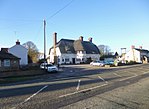Rode Hall

Rode Hall, a Georgian country house, is the seat of the Wilbraham family, members of the landed gentry in the parish of Odd Rode, Cheshire, England. The estate, with the original timber-framed manor house, was purchased by the Wilbrahams from the ancient Rode family in 1669. The medieval manor house was replaced between 1700 and 1708 by a brick-built seven-bay building; a second building, with five bays, was built in 1752; the two buildings being joined in 1800 to form the present Rode Hall. Both the exterior and interior of Rode Hall have been altered multiples times, including work by Thomas Farnolls Pritchard and Lewis Wyatt, resulting in an irregular and complex layout. The house has large collections of period paintings, furniture, and porcelain by Chelsea, Bow and Royal Worcester. The house is Grade II* listed, and is surrounded by parkland and formal gardens, which are included as Grade II on the National Register of Historic Parks and Gardens. On the site are a grotto, an ice house, and an ornamental obelisk, all Grade II listed structures. Rode Hall is still owned and occupied by the Wilbrahams, currently by the 9th Baronet, Sir Randle Baker Wilbraham. The hall and gardens are open to the public from April to September.
Excerpt from the Wikipedia article Rode Hall (License: CC BY-SA 3.0, Authors, Images).Rode Hall
Poolside,
Geographical coordinates (GPS) Address Nearby Places Show on map
Geographical coordinates (GPS)
| Latitude | Longitude |
|---|---|
| N 53.112896 ° | E -2.272006 ° |
Address
Rode Hall
Poolside
ST7 3QS , Odd Rode
England, United Kingdom
Open on Google Maps







